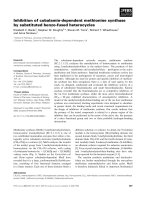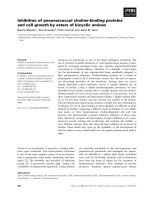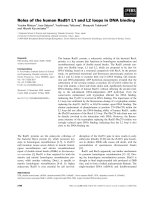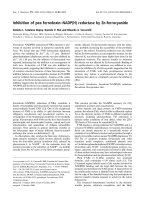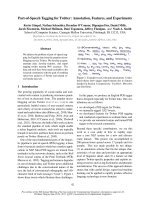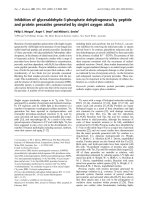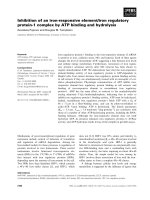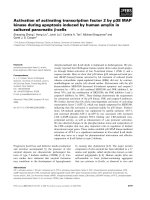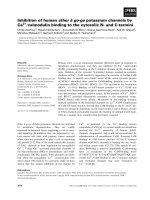Báo cáo khoa học: Inhibition of recombinant human maltase glucoamylase by salacinol and derivatives pdf
Bạn đang xem bản rút gọn của tài liệu. Xem và tải ngay bản đầy đủ của tài liệu tại đây (306.5 KB, 11 trang )
Inhibition of recombinant human maltase glucoamylase
by salacinol and derivatives
Elena J. Rossi
1,2,
*, Lyann Sim
1,2,
*, Douglas A. Kuntz
2
, Dagmar Hahn
3
, Blair D. Johnston
4
,
Ahmad Ghavami
4
, Monica G. Szczepina
4
, Nag S. Kumar
4
, Erwin E. Sterchi
3
, Buford L. Nichols
5
,
B. M. Pinto
4
and David R. Rose
1,2
1 Department of Medical Biophysics, University of Toronto, Canada
2 Division of Cancer Genomics and Proteomics, Ontario Cancer Institute, Canada
3 Institute of Biochemistry and Molecular Medicine, University of Berne, Switzerland
4 Department of Chemistry, Simon Fraser University, Burnaby, Canada
5 US Department of Agriculture, Agricultural Research Service, Baylor College of Medicine, Houston, TX, USA
In the treatment of Type II (noninsulin-dependent)
diabetes, management of blood glucose levels is crit-
ical. One strategy is to delay digestion of ingested
carbohydrates, thereby lowering postprandial blood
glucose concentration [1]. This can be achieved by
inhibiting the activity of pancreatic a-amylase, which
mediates the hydrolysis of complex starches to oligo-
saccharides, and ⁄ or membrane-bound intestinal
a-glucosidases, which hydrolyze these oligosaccharides
to glucose in the small intestine [1]. Carbohydrate ana-
logues, such as acarbose (1) and miglitol (2) (Fig. 1)
reversibly inhibit the function of these two groups of
enzymes [2] resulting in delayed glucose absorp-
tion into the blood and a smoothing or lowering of
Keywords
enzyme inhibition; family GH31;
glucosidase; glycosyl hydrolase; salacinol
Correspondence
D. R. Rose, Ontario Cancer Institute, 101
College Street, Toronto, ON, M5G 1L7
Canada
Fax: +416 581 7562
Tel: +416 581 7537
Email:
/>*These authors contributed equally to this
work
(Received 5 January 2006, revised 11 April
2006, accepted 13 April 2006)
doi:10.1111/j.1742-4658.2006.05283.x
Inhibitors targeting pancreatic a-amylase and intestinal a-glucosidases
delay glucose production following digestion and are currently used in the
treatment of Type II diabetes. Maltase-glucoamylase (MGA), a family 31
glycoside hydrolase, is an a-glucosidase anchored in the membrane of small
intestinal epithelial cells responsible for the final step of mammalian starch
digestion leading to the release of glucose. This paper reports the produc-
tion and purification of active human recombinant MGA amino terminal
catalytic domain (MGAnt) from two different eukaryotic cell culture sys-
tems. MGAnt overexpressed in Drosophila cells was of quality and quantity
suitable for kinetic and inhibition studies as well as future structural stud-
ies. Inhibition of MGAnt was tested with a group of prospective a-glucosi-
dase inhibitors modeled after salacinol, a naturally occurring a-glucosidase
inhibitor, and acarbose, a currently prescribed antidiabetic agent. Four
synthetic inhibitors that bind and inhibit MGAnt activity better than acar-
bose, and at comparable levels to salacinol, were found. The inhibitors are
derivatives of salacinol that contain either a selenium atom in place of
sulfur in the five-membered ring, or a longer polyhydroxylated, sulfated
chain than salacinol. Six-membered ring derivatives of salacinol and
compounds modeled after miglitol were much less effective as MGAnt
inhibitors. These results provide information on the inhibitory profile
of MGAnt that will guide the development of new compounds having
antidiabetic activity.
Abbreviations
HPA, human pancreatic a-amylase; MGA, maltase glucoamylase; MGAnt, maltase glucoamylase N-terminal catalytic domain; pNP, para-
nitrophenyl; SIM, sucrase isomaltase.
FEBS Journal 273 (2006) 2673–2683 ª 2006 The Authors Journal compilation ª 2006 FEBS 2673
postprandial hyperglycemia [3,4] (Fig. 1). Because
these inhibitors decrease both hyperglycemia and
hyperinsulinemia, they reduce insulin resistance and
stress on the beta-cells of the pancreas, thus preventing
further insulin-dependent disorders [5–7].
Starch, one of the main digestible carbohydrates in
the human diet, is composed of approximately 25%
amylose and 75% amylopectin [9]. Mammalian starch
digestion occurs in the lumen of the small intestine
where the endoglycosidase a-amylase (EC 3.2.1.1)
hydrolyzes the internal a-(1–4) linkages of starch while
bypassing the a-(1–6) linkages of the amylopectin com-
ponent. This hydrolysis yields both linear maltose
oligosaccharides and branched isomaltose oligosaccha-
rides, neither of which can be absorbed into the blood-
stream without further processing [8]. These linear and
branched oligosaccharides are hydrolyzed at the non-
reducing end by maltase glucoamylase (MGA; E.C.
3.2.1.20 and 3.2.1.3) maltase glucoamylase and sucrase
isomaltase (SIM; EC 3.2.1.48 and 3.2.1.10), respect-
ively, to yield glucose [9]. MGA and SIM have over-
lapping and complementary substrate specificities in
Fig. 1. Inhibitors discussed in this paper: acarbose (1), miglitol (2), salacinol (3) and kotalanol (4); (5–7) are derivatives of salacinol with substi-
tutions in the ring. (8–9) are ring expanded salacinol derivatives. (10)and(11) are miglitol derivatives. (12–15) are derivatives of salacinol with
variations in the length and stereochemistry of the aliphatic chain. Figures in brackets indicate the degree of inhibition of MGAnt dependent
maltose hydrolysis in the presence of 200 l
M of inhibitor, when measured with 1 mM maltose as substrate. Glucose release was monitored
using the glucose oxidase assay as described in Experimental procedures. Values are ± 10%. These conditions (1 ⁄ 4K
m
) permitted a meas-
urable effect from weak competitive inhibitors.
Inhibition of human maltase glucoamylase E. J. Rossi et al.
2674 FEBS Journal 273 (2006) 2673–2683 ª 2006 The Authors Journal compilation ª 2006 FEBS
starch digestion. SIM accounts for almost all sucrase
activity, all isomaltase activity, and 80% of the maltase
activity, while MGA accounts for all glucoamylase
activity, 20% of the maltase activity, and 1% of the
sucrase activity [10]. Together, these two enzymes form
a complex in the epithelial cells of the small intestine
and complete the hydrolysis of oligosaccharide chains
in starch digestion.
Human MGA encoded by the gene MGAM [8,11] is
an a-glucosidase responsible for hydrolysis of a-1,4-
linkages from the nonreducing end of maltose oligo-
saccharides [9] and belongs to glycoside hydrolase
family 31. It is type II membrane protein 1857 amino
acids in length anchored in the brush border epithelial
cells of the small intestine. MGA contains five distinct
protein domains: a small cytosolic domain (26 amino
acids) a transmembrane domain (20 amino acids), an
O-glycosylated linker (or stalk) (55 amino acids), and
two homologous (family GH31) catalytic domains
(each 900 amino acids) [9]. The domain organization
is illustrated schematically in Fig. 2. Each MGA cata-
lytic domain contains a putative catalytic site made up
of the amino acid sequence tryptophan-X-aspartate-
methionine-asparagine-glutamate (WXDMNE), where
X indicates a variable amino acid. This catalytic site is
conserved in other human a-glucosidases and family
31 enzymes including SIM [12]. Human SIM is the clo-
sest known homologue of hMGA, sharing 59% amino
acid sequence identity, and is responsible for the hydro-
lysis of branched a-1,6-linked oligosaccharides [8].
Due to its role in starch digestion, MGA has
become an important inhibition target in the treatment
of Type II diabetes. Although 1 and 2 (Fig. 1) are
currently being used to treat Type II diabetes, they
are accompanied by undesirable side-effects, including
gastrointestinal and abdominal discomfort [2]. For this
reason, there is a drive to identify alternative a-glucosi-
dase inhibitors with greater potency and fewer side-
effects.
The naturally occurring glucosidase inhibitors
salacinol (3) and kotalanol (4) (Fig. 1) have been iso-
lated from Salacia reticulata, a plant native to Sri
Lanka and India that has been used in the Ayurvedic
system of medicine for the treatment of diabetes
[13,14]. Compounds 3 and 4 (Fig. 1) may potentially
have fewer long-term side-effects than other existing
oral antidiabetic agents. Recent animal studies have
shown that the oral ingestion of an extract from a
S. reticulata trunk at a dose of 5000 mgÆkg
)1
had no
serious acute toxicity or mutagenicity in rats [15].
We have been active in the synthesis and biological
evaluation of analogues of 3 (Fig. 1), differing in
stereochemistry at the stereogenic centers, in ring-
heteroatom substitution, and in ring size [16–22].
In vitro testing has revealed different inhibitory activ-
ities of these compounds against different glycosidase
enzymes [23,24]. In addition, 3, and the selenium ana-
logue, blintol 5 (Fig. 1), have been shown to be very
effective in controlling blood glucose levels in rats
after a carbohydrate meal, thus providing lead candi-
dates for the treatment of Type 2 diabetes [23]. In
order to examine the mechanism of action of this
class of inhibitors, 3, 5, the stereoisomers of salacinol
6, 7 [25], and the six-membered ring analogues of
salacinol (8, 9) (N. S. Kumar and B. M. Pinto,
unpublished results) were synthesized along with
analogues of miglitol (10, 11) [22]. In view of the
reported antiglucosidase activity of 4 [14], we also
synthesized chain-extended analogues ( 12 –15) (Fig. 1)
[26], whose acyclic, polyhydroxylated, sulfated chains
varied between the four-carbon chain of salacinol and
the seven-carbon chain of kotalanol.
Fig. 2. Schematic diagram of MGA protein
organization and expression construct.
Amino acid boundaries of each of the
domains comprising the full size protein,
and the region inserted into the Drosophila
expression plasmid, are indicated.
E. J. Rossi et al. Inhibition of human maltase glucoamylase
FEBS Journal 273 (2006) 2673–2683 ª 2006 The Authors Journal compilation ª 2006 FEBS 2675
It has been difficult previously to carry out extensive
studies on the inhibitor profiles of these compounds
due to the lack of large amounts of active enzyme.
Here we report heterologous overexpression of recom-
binant DNA encoding the MGA amino terminal cata-
lytic domain (MGAnt) in Drosophila S2 cells in order
to overcome this difficulty. The purified recombinant
MGAnt was then used to perform kinetic analyses of
prospective MGA inhibitors.
Results
The N-terminal catalytic domain of MGA is presently
the most extensively studied region of the enzyme and
enzymatic activity of the domain has been reported in
the presence of maltose and amylose substrates, with
little or no activity in the presence of lactose or sucrose
substrates [8]. While the function of the C-terminal
domain has yet to be determined, the results of Nich-
ols et al. [8] confirmed that the N-terminal domain
contains the substrate specificity of MGA and is dis-
tinct from the specificity of SIM. For this reason, the
recombinant proteins used in the studies reported here
were designed to contain only the N-terminal region
and all kinetic and inhibition analysis was performed
using this catalytic domain.
Activity of salacinol and acarbose on mammalian
cell expressed C-terminally truncated MGA
Preliminary inhibition studies were performed on
sonicated cell extracts of primate cells expressing
C-terminally truncated MGA [8]. In this assay, COS-1
cells transiently transfected with the MGA-P1A2
construct, which encodes the complete amino-terminal
portion of the molecule including the membrane anchor
and 5¢-catalytic domain, were used. The inhibition of
maltose (4-O-a-d-glucopyranosyl-d-glucose) hydrolysis
was monitored. The activity of the known glycosidase
inhibitor acarbose (Bayer), used for the treatment of
Type II diabetes, was compared to that of salacinol.
Whereas salacinol at 5 lm concentration inhibited 60–
70% of the breakdown of maltose, 5 lm acarbose only
inhibited 4% of the activity. Thus, it would appear that
acarbose acts mainly by inhibiting human pancreatic
a-amylase (HPA) and the breakdown of starch, and
possibly other intestinal glucosidases but not MGA.
The synthetic analogues of salacinol appeared to be
slightly more active than the parent compound in these
crude extracts. At 0.2 lm, blintol 5 inhibited 50% of
MGA activity, and the chain extended analogues
(13–15) inhibited 88%, 91%, and 90% of MGA activ-
ity, respectively, when tested at 5 lm.
Expression of active recombinant MGAnt
in Drosophila S2 cells
Due to limited expression levels in COS-1 cells and dif-
ficulties in purification of the resultant membrane
anchored protein we decided to express the catalytic
domain as a secreted protein in Drosophila melanoga-
ster cells (DES system, Invitrogen). We designed a
construct that lacked the cytosolic, transmembrane
region and most of the O-glycosylated stalk region that
occurs at the amino terminus (Fig. 2). The N-terminal
catalytic domain of MGA, starting at Ser87 and end-
ing at amino acid 955, was fused to a C-terminal hexa-
histidine tag. This domain was placed downstream of
a metallothionein promoter and behind a Bip secretion
signal. Correctness of the construct was determined by
sequencing in each direction. An active protein was
successfully expressed in Drosophila S2 cells. Secreted
protein was isolated from the cell media using chelat-
ing Sepharose resin and was further purified using
anion exchange chromatography. The total yield of
pure MGA from expression in Drosophila S2 cells
was approximately 14 mgÆL
)1
. The size and purity of
the final protein preparation was determined by
SDS ⁄ PAGE analysis (Fig. 3, inset) and by mass spec-
trophotometric analysis. The expected size of the 876
amino acid expressed domain is 99 274 while a mass
of 105 360 was determined by MALDI-TOF MS. The
difference in mass is a result of glycosylation (six pre-
dicted sites) as treatment with endo-glycosidase F
reduced the apparent mass of the enzyme (results not
shown).
Fig. 3. MGAnt enzyme activity with maltose as a substrate. Line-
weaver-Burk plot of MGAnt activity used to calculate kinetic param-
eters V
max
and K
m
. Enzyme activity was measured by monitoring
release of glucose from maltose using the glucose oxidase assay.
Inset shows an SDS ⁄ PAGE gel of the purified MGAnt used in the
assay. The size of the molecular weight markers shown in lane 1
are indicated. Lanes 2 and 3 show different loadings of the protein.
Inhibition of human maltase glucoamylase E. J. Rossi et al.
2676 FEBS Journal 273 (2006) 2673–2683 ª 2006 The Authors Journal compilation ª 2006 FEBS
Data obtained from the analysis of MGAnt activity
in the presence of increasing maltose concentration
was used in a double reciprocal Lineweaver–Burk plot
(1 ⁄ velocity versus 1 ⁄ substrate) in order to calculate
the V
max
and K
M
of the reaction (Fig. 3). The V
max
was determined to be 32.6 ± 1.4 Units ⁄ mg enzyme
and the K
M
4.6 ± 0.5 mm maltose. This differs some-
what from the previously published results for purified
murine MGA (34.7 UÆmg
)1
, 1.24 mm, respectively) [27]
but it must be pointed out that the purified rodent
enzyme was almost twice the size of full size human
MGA and was composed of a number of disulfide-
linked proteolytic fragments [27]. The K
M
is close to
the 3.4 mm measured for human MGA immunoprecip-
itated from pooled clinical homogenates (B. Nichols,
unpublished results).
Inhibition analysis
The availability of larger amounts of recombinant
enzyme permitted a more thorough analysis of the
inhibitor activities than was possible with the COS-1
homogenates. The effectiveness of a-glucosidase inhibi-
tors on recombinant human MGAnt was tested using
maltose as a substrate in the presence of known inhibi-
tors acarbose and salacinol, and 11 newly synthesized
putative inhibitors (Fig. 1). Initially, each inhibitor was
tested at a concentration of 200 lm in order to screen
for the most effective inhibitors. The inhibition results
of the initial screening are listed along with each com-
pound in Fig. 1. Of the 11 new putative inhibitors tes-
ted, only inhibitors 5, 13, 14 and 15 showed full
enzyme inhibition at 200 lm and were used in further
inhibition analysis. As expected, the known a-glucosi-
dase inhibitor salacinol also showed full inhibition at
this concentration. Acarbose did not inhibit as well as
salacinol or the four synthetic inhibitors but it was
used in further analysis for the sake of comparison.
The inhibition constants (K
i
) of acarbose, salacinol
and (5, 13–15; Fig. 1), against MGA were determined
using the glucose oxidase assay and maltose as a sub-
strate. Data points were obtained, in triplicate, for
four different inhibitor concentrations (including 0 lm)
and up to six different maltose concentrations. Tripli-
cate data points pertaining to the various levels of each
inhibitor were averaged and plotted together in Line-
weaver–Burk plots and trendlines were added using
Excel. The slopes of the lines corresponding to inhib-
itor concentration approximately intersected at a point
at the y-axis indicating classic competitive inhibition.
The experimentally determined inhibition constants for
acarbose, salacinol and its synthetic analogues (5, 13–
15) are listed (Table 1) and the Dixon plot visualiza-
tion given in Fig. 4. Salacinol and 15 showed the best
inhibition against MGA (K
i
¼ 0.2 lm) while acarbose
showed the worst inhibition (K
i
¼ 62 lm). These val-
ues are comparable to the preliminary data described
above in COS-1 cells, despite the differences in assays
and source of enzyme.
Discussion
Initial expression of active MGAnt protein in COS-1
cells demonstrated the validity of the cDNA clones,
but suffered from low yields and the difficulty in isola-
ting large quantities for physico-chemical studies. The
Drosophila S2 cell expression system proved to be a
successful method for the production of MGAnt in
substantial quantities. The N-terminal catalytic domain
was expressed and secreted into the medium, from
which it was purified with sufficient purity (> 95%)
and yield (> 40 mg ⁄ 3 L) for use in kinetic and inhibi-
tion analysis as well as future use in structural studies.
Kinetic analysis confirmed the enzyme activity of the
recombinant protein, and inhibition analysis confirmed
classic competitive inhibition by a-glucosidase inhibi-
tors. Salacinol with a K
i
of 0.2 lm was the best inhib-
itor tested. Acarbose had a K
i
of 62 lm against
MGAnt. Through preliminary inhibitor screens, with
maltose as a substrate for MGAnt, four new small
molecules were discovered as promising a-glucosidase
inhibitors from a group of 11 compounds designed
and synthesized specifically for MGA inhibition.
It is generally accepted that MGA, similar to SIM,
has a negatively charged region in its catalytic center
due to the presence of highly conserved acidic amino
acid residues that are necessary for enzyme activity
[8,28]. This provides an explanation for the high affin-
ity of inhibitors such as acarbose and miglitol because
upon binding, the inhibitor is protonated at its nitro-
gen atom resulting in a positive charge that interacts
tightly with the negatively charged residues in the act-
ive site [28,29]. Salacinol, with a positively charged sul-
fur atom, also contains a zwitterionic sulfonium-sulfate
Table 1. Experimentally determined K
i
values. Inhibition constants
were determined using maltose as a substrate for MGA. K
i
values
were calculated according to each tested inhibitor concentration and
averaged for a final result. Errors indicate the range of the data.
Inhibitor K
i
(lM)
Acarbose (1) 62.0 ± 13
Salacinol (3) 0.19 ± 0.02
5 0.49 ± 0.05
13 0.26 ± 0.02
14 0.25 ± 0.02
15 0.17 ± 0.03
E. J. Rossi et al. Inhibition of human maltase glucoamylase
FEBS Journal 273 (2006) 2673–2683 ª 2006 The Authors Journal compilation ª 2006 FEBS 2677
structure that is thought to mimic the oxocarbenium
ion intermediates in glycoside hydrolysis reactions [20].
There is a current debate as to whether carbohydrate
mimics containing sulfonium ions and ammonium ions
are effective inhibitors because of their ability to mimic
the shape and charge of the presumed transition state,
or because they bind with high affinity due to electro-
static interactions with a carboxylate residue in the
enzyme active site [16,18]. If electrostatic stabilization
is the key to enzyme affinity, inhibitors bearing a
permanent positive charge should function as well or
better than current glycosidase inhibitors, as proven by
the effectiveness of salacinol [16,18].
Inhibitors modeled after salacinol, all contain either
a sulfur or a selenium atom resulting in a permanent
positive charge in the five-membered ring. The differ-
ences between these seven salacinol analogues involve
the stereochemistry at the stereogenic centers in the
polyhydroxylated, sulfated chain, as well as the num-
ber of carbons in the acyclic chain linked to the
6
4
2
0
-200
-100
0 100 200
8
6
4
2
0
-3
-2
-1 0
12
3
[Salacinol (3)] (µ
M)
[Acarbose (1)] (µ
M)
1/A450
1/A450
6
4
2
0
-3 -2 -1 0 1 2 3
[5] (µ
M)
[13] (µ
M)
6
4
2
0
-3 -2 -1 0 1 2 3
1/A450
1/A450
-3 -2
-1
0
1
2
3
[14] (µ
M)
[15] (µ
M)
12
10
10
8
6
4
2
0
8
6
4
2
0
-3 -2
-1
0
1
2
3
1/A450
1/A450
Fig. 4. Dixon plot analysis of the inhibition of MGAnt by acarbose and compounds 3, 5, 13, 14,and15 (Fig. 1) with fixed maltose concentra-
tions of 5 m
M (open circles), 7.5 mM (filled circles), 15 mM (open squares) and 30 mM (filled squares).
Inhibition of human maltase glucoamylase E. J. Rossi et al.
2678 FEBS Journal 273 (2006) 2673–2683 ª 2006 The Authors Journal compilation ª 2006 FEBS
sulfur ⁄ selenium atom. The remaining four of the 11
tested inhibitors, 8–11 (Fig. 1), were modeled after
miglitol. These inhibitors each have a six-membered,
cyclic alditol structure, with a positively charged sulfur
or nitrogen in the ring. They also contain a four-car-
bon chain linked to the positively charged atom, sim-
ilar to salacinol and its derivatives. As in the case of
salacinol, it was presumed that the permanent positive
charge in the six-membered ring would lead to electro-
static stabilization and increased active site affinity;
however, none of these four inhibitors proved to be
effective against MGAnt. This suggests that while the
positive charge may be important in stabilizing active
site interactions, the ring size also affects binding in
the enzyme active site. The fact that salacinol, contain-
ing a five-membered ring, has proven to be as effective,
and in some cases more effective than both 1 and 2
(Fig. 1), suggests that the positively charged five-mem-
bered ring is a better transition-state mimic because of
its ring shape [29,30].
A preliminary inhibition screen showed four com-
pounds of the group of salacinol analogues that
were the most potent inhibitors of MGAnt activity (5,
13–15) (Fig. 4). The common element of these four
derivatives is the identical stereochemistry at the carbon
centers in the heteroalditol ring to that of salacinol.
Inhibitor 5 is most similar to salacinol in that the only
alteration is the replacement of the ring sulfur atom by
selenium. Inhibitors 6 and 7, which were not effective
as inhibitors of MGAnt, differ from salacinol (3)in
stereochemistry at the carbon centers in the ring. These
results suggest that the stereochemistry at these centers
is critical for effective inhibition, the OH groups at
C-2 and C-3 interacting with complementary groups in
the enzyme active site. The five-membered carbon ring
is likely the portion of the molecule that is most
important in conferring affinity for the enzyme active
site. This conclusion is reinforced by the observation
that the four best inhibitors share three different
carbon chain lengths linked to the ring heteroatom,
suggesting that the chain length does not play a pre-
dominant role in the binding or effectiveness of the
inhibitors. Unfortunately, kotalanol, with the longest
chain length, was not available for this study. The ana-
lysis is clearly an oversimplification, since compound 12
was proven to be ineffective although it shares the same
ring stereochemistry as salacinol and compounds 5, 13,
14 and 15. The major difference between compound 12
and the four effective inhibitors is in the stereochemis-
try at C-4’. The stereochemistry at C-3’, and hence the
placement of the sulfate group in the enzyme active site,
does not appear to be important for enzyme inhibition
(compare 12 against 13 and 15 in Fig. 1). Following the
preliminary screen, each of the four most promising
inhibitors was used in further inhibition analysis
to determine their K
i
values for comparison with the
a-amylase inhibitor, acarbose and salacinol (Table 1).
Determination of the inhibition constants showed that
salacinol and its four most potent derivatives have K
i
values in the low micromolar range (0.2–0.5 lm ), while
acarbose is approximately 15–20-fold less potent
against MGAnt (K
i
¼ 62 lm, Fig. 4).
This poor inhibition of the purified catalytic domain
by acarbose was unexpected from previous reports in
which acarbose was reported to be a powerful a-glu-
cosidase inhibitor, with an effectiveness comparable to
salacinol [2,28,32], although it is consistent with our
preliminary data described above. One study reported
acarbose inhibition against human MGA isolated from
intestinal scrapings to be in the low micromolar range
[28]. Acarbose is a very powerful inhibitor of human
pancreatic a-amylase with a reported K
i
of 15 nm [33].
However the method of action of acarbose is quite
complex and it appears to be acting as a type of sui-
cide inhibitor of a-amylase in a mechanism whereby
the acarbose is rearranged into an active entity by the
a-amylase [33]. Thus the acarbose itself is not the act-
ive inhibitor. The active rearranged entity may be
inhibitory to MGA and could be generated in the
intestinal scrapings by a-amylase present in the hetero-
geneous sample or by activity in the C-terminal
domain of the full-size protein, thereby accounting for
the inhibition by ‘acarbose’ reported previously [28].
Our previous studies of the inhibitory effect of salac-
inol and its derivatives against human a-amylase and
fungal glucoamylase, rather than MGA, report the
effectiveness of salacinol to be in the millimolar range
[16,18,20]. In addition the analogues 5 and 13–15 did
not inhibit human pancreatic a-amylase (S. G. Withers
and B. M. Pinto, unpublished results). The present
study reports activities of salacinol and synthetic deriv-
atives, against active human recombinant MGAnt. By
confirming the higher potency of salacinol and its
derivatives against human MGAnt as compared with
a-amylase and fungal glucoamylase, our results suggest
that the inhibitors show specificity towards different
a-glucosidases. This observation is important clinically
because the design of a-glucosidase inhibitors for the
treatment of Type II diabetes might require specificity
for enzymes later in the starch digestion pathway in
order to reduce unwanted side-effects.
The inhibition constants of the most effective inhibi-
tors found in this study, salacinol and compounds 5,
13, 14 and 15, are relatively similar, with salacinol and
15 being slightly more potent (0.2 lm) (Table 1).
Inhibitors 13 and 15 show similar inhibition, with K
i
E. J. Rossi et al. Inhibition of human maltase glucoamylase
FEBS Journal 273 (2006) 2673–2683 ª 2006 The Authors Journal compilation ª 2006 FEBS 2679
values of approximately 0.25 lm. Inhibitor 5 is slightly
worse at 0.5 lm. Thus, for these four salacinol deriva-
tives, the nature of the heteroatom or the length of the
acyclic chain does not appear to have a significant
effect on inhibitory activity. Since the stereochemistry
at C-3¢ on the acyclic chain in 14 is opposite to that in
5, 13 and 15 it would appear that placement of the
sulfate moiety within the active site is not significant
for enzyme inhibition.
It would appear then that the critical features of a
potent inhibitor with an extended acyclic chain would
be the stereochemistry at C-4¢, present in 13, 14 and
15, the stereochemistry at C-2¢ and C-3¢ being unim-
portant. It would also appear that C-5¢ and C-6¢ pro-
trude from the active site and make no substantial
contacts with the enzyme since similar inhibitory activ-
ities were observed for 13, 14 and 15. While the initial
results of the inhibition assays are promising, at this
point analysis of structure activity relationships can
only be somewhat speculative. However the results of
this study set the stage for improvement of the specific-
ity and affinity of these compounds towards their
potential development as antidiabetics.
Further confirmation of the importance of inhibitor
stereochemistry and how it affects binding in the active
site will only be possible with an analysis of the atomic
structure of the MGA binding site in both the presence
and absence of bound inhibitor. Determination of this
structural information, building on the groundwork
reported in this study, will be a valuable tool in future
design and synthesis of a-glucosidase inhibitors effect-
ive against and specific to MGA. These inhibitors
should be promising lead candidates as oral agents for
the treatment and prevention of Type II diabetes.
Experimental procedures
Intestinal maltase assay
Recombinant expression of C-terminally truncated human
MGA in COS-1 cells has been published [8]. The COS cells
transiently transfected with MGA-P1A2 were scraped off
the tissue culture plates in 150 mm KCl. Aliquots were so-
nicated and assayed for hydrolysis of 2% maltose for 2 h
at 37 °C by the Dahlqvist method [34]. The reaction was
stopped by boiling and glucose production was measured
by the glucose oxidase assay (below). Protein was measured
with a Bio-Rad (Hercules, CA, USA) protein assay kit.
Recombinant MGAnt in Drosophila S2 cells
The N-terminal catalytic domain of human MGA was
expressed in Drosophila cells. The coding sequence was
isolated from MGA-P1A2, which lacks the 903 amino acid
C-terminal domain [8]. We also chose to delete the base
pairs coding for the N-terminal cytosolic domain, the trans-
membrane domain, and most (39 ⁄ 52 amino acids) of the
O-glycosylated stalk region to give a construct encoding
only the 876 amino acid catalytic domain of MGA. The
expression construct was made in three steps from MGA-
P1A2. In the first step deletion of the coding sequence for
the 86 amino acid N-terminal region was carried out. An
upstream primer (ccccggCTCGAGATCTgctgaatgtccagtggt)
was synthesized which contains a CG tail, overlapping XhoI
and BglII sites (capitalized) and 20 bp of complementary
sequence. The TCT at the end of the BglII site codes for
Serine87 of the full size MGA. For PCR, the upstream pri-
mer was used in combination with a downstream primer,
ACGTTAGTGCTAGGCAGTCGAG, which binds about
60 bp downstream of the XhoI site at nt1866 in MGA-
P1A2. The PCR product was digested with XhoI, and
ligated with a 6322 bp fragment of XhoI cut MGA-P1A2.
The resulting plasmid, pBY_1, was cut with BglII and NotI,
and ligated into BglII ⁄ NotI cut pMT ⁄ BiP ⁄ V5-His vector
(Invitrogen, Carlsbad, CA, USA) to give pBY_2. This was
in turn digested with NotI and AgeI to remove 74 bp of
extra sequence. The ends were made blunt with mung bean
nuclease, and ligated together to give the expression vector
pMT-Bip-MGAnt-His6. This construct allows secretion of
the MGAnt into the culture medium under the control of a
metallothionein promoter with an in-frame C-terminal
hexa-histidine tail for purification.
Transfection, selection and isolation
of single-cell clones
The Drosophila Expression System (DES: Invitrogen) with
Schneider 2 (S2) cells was used to express and secrete
recombinant MGAnt. The S2 cells were maintained at
25 °C as a semiadherent monolayer in Schneider’s Insect
Medium (Sigma, St Louis, MO, USA) enriched with 10%
heat-inactivated fetal bovine serum (FBS). The cells were
split with enriched media at a ratio of 1 : 4 every 3–4 days
until transfection. The recombinant MGAnt vector was
transfected, in combination with the pCoBLAST selection
vector, which contains a blasticidin resistance cassette under
the control of the Drosophila copia promoter, into S2 cells
using the calcium phosphate procedure. Cells at a concen-
tration of 3 · 10
6
cellsÆmL
)1
were transfected with 19 lg
of expression vector and 1 lg of selection vector. The
procedure is carried out in duplicate to allow for one tran-
siently and a second stably transfected cell line. Transfected
cells were washed the next day with enriched medium to
remove the calcium phosphate solution. Two days later, the
transiently transfected cells were induced with 10 lm CdCl
2
and after a further three days, the cell medium was assayed
for protein expression by SDS ⁄ PAGE and immunoblotting
Inhibition of human maltase glucoamylase E. J. Rossi et al.
2680 FEBS Journal 273 (2006) 2673–2683 ª 2006 The Authors Journal compilation ª 2006 FEBS
with antipentaHis antibody (Qiagen, Montreal, Canada). In
order to obtain stably transfected cells, transfectants were
passaged for one month in selective medium [enriched med-
ium containing 16 lgÆmL
)1
blasticidin (Invitrogen)]. These
stably transfected blasticidin-resistant populations were
used for subsequent single cell selection and scale-up.
Successfully transfected cells were diluted with blastici-
din-containing enriched medium to 10–50 cellsÆmL
)1
, mixed
with nontransfected S2 cells (to serve as a feeder layer), and
grown in 100 lL volumes in a 96-well tissue culture plate
until single colonies of cells developed. Levels of active
MGAnt secreted into the medium were analyzed by hydro-
lysis of pNP-glucose. A stable line of optimally expressing
single cell clone was adapted to Ex-Cell 420 Insect Serum
Free Media (JRH Biosciences, Lenexa, KS, USA) and then
scaled up to 3200 mL in shaker flasks. Cells were then
induced with 2 lm CdCl
2
, and the secreted protein was har-
vested after 3 days.
Protein purification
Secreted protein was batch-bound from the media using
chelating Sepharose resin (GE Healthcare, Montreal, Can-
ada) at a ratio of approximately 3 lL resin to 1 mL media.
Copper sulfate was added to 200 lm and imidazole was
added to 2 mm to reduce nonspecific binding. Resin was
poured into a column and washed with 20 column volumes
of 20 mm Tris pH 8.5, 300 mm NaCl. Protein was eluted
step-wise with 2, 6, 10, 20, 30, and 50 mm imidazole in
wash buffer. Eluted fractions were analyzed using
SDS ⁄ PAGE and the pNP-glucose activity assay to identify
fractions containing active MGAnt. These fractions were
pooled, concentrated, and dialyzed against 100 mm NaCl,
20 mm Tris pH 8.5 to remove residual copper and imidaz-
ole, and to lower the salt concentration of the sample in
preparation for ion exchange chromatography.
A BioCAD Poros-HQ anion exchange column (PerSep-
tive Biosystems, Framingham, MA, USA) was used to
further purify the MGAnt. The column was washed and
equilibrated with starting buffer, 100 mm Bis-Tris Propane
pH 7. Sample was diluted by half with 100 mm Bis-Tris
Propane pH 7 then was loaded on column and washed with
starting buffer. Sample was eluted over a linear gradient of
0–1 m NaCl. Eluate was collected in 3 mL fractions and
assayed for active MGA using SDS ⁄ PAGE and pNP-glu-
cose assay. Fractions containing pure, active MGAnt were
pooled and concentrated to 23 mgÆmL
)1
.
Inhibitors
Acarbose 1, salacinol 3 and synthesized derivatives were
analyzed as inhibitors for recombinant human MGAnt
using the glucose oxidase enzyme activity assays described
below. The inhibitors were dissolved in water as 50 mm
stock solutions and stored at )20 °C.
Enzyme activity assay
Two methods were used to assess MGAnt activity. For
rapid measurements of cell supernatants and assessment of
column fractions the pNP-glucose assay was used. For
detailed kinetic analysis the glucose-oxidase assay was used.
pNP-glucose assay
Reactions were carried out in 50 mm Mes buffer, pH 5.75,
with 5 mm of para-nitrophenol-d-glucopyranoside (pNP-
glucose, Sigma) as substrate. Reaction volumes were 50 lL
in 96-well microtiter dishes. Reactions were incubated at
37 °C, and at the completion of the reaction (typically 30–
45 min) were stopped with 50 lL of 0.5 m sodium carbon-
ate. The absorbance of the reaction product was measured
at 405 nm with 520 nm background correction in a micro-
titer plate reader.
Glucose-oxidase assay
Analysis of MGAnt inhibition was performed using maltose
as the substrate, and measuring the release of glucose. Reac-
tions were carried out in 100 mm Mes buffer, pH 6.5, at
37 °C for 15 min. The reaction was stopped by boiling for
3 min 20 lL aliquots were taken and added to 100 lL of glu-
cose oxidase assay reagent (Sigma) in a 96-well plate. Reac-
tions were developed for 1 h and absorbance was measured
at 450 nm to determine the amount of glucose produced by
MGA activity in the reaction. One unit of activity is defined
as the hydrolysis of one micromole of maltose per minute.
All reactions were performed in triplicate and absorbance
measurements were averaged to give a final result.
Enzyme kinetics
Kinetic parameters of recombinant MGAnt were deter-
mined using the glucose oxidase assay to follow the produc-
tion of glucose upon addition of enzyme (25 nm)at
increasing maltose concentrations (from 2.5 to 30 mm) with
a reaction time of 15 min. Reactions were linear within this
time frame. The program GraFit 4.0.14 was used to fit the
data to the Michaelis-Menten equation and estimate the
kinetic parameters, K
m
and V
max
, of the enzyme. K
i
values
for each inhibitor were determined by measuring the rate of
maltose hydrolysis by MGAnt at varying inhibitor concen-
trations. Data were plotted in Lineweaver-Burk plots
(1 ⁄ rate versus1 ⁄ [substrate]) and K
i
values for the compet-
itive inhibition were determined by the equation K
i
¼
K
m
[I] ⁄ (V
max
)s ) K
m
, where ‘s’ is the slope of the line. The
K
i
reported for each inhibitor was estimated by averaging
the K
i
values obtained from each of the different inhibitor
concentrations. For ease of visualization, the inhibition
analyses are presented as Dixon plots in Fig. 4.
E. J. Rossi et al. Inhibition of human maltase glucoamylase
FEBS Journal 273 (2006) 2673–2683 ª 2006 The Authors Journal compilation ª 2006 FEBS 2681
Acknowledgements
We thank Brenda Yun, Tara Signorelli, and Marees
Harris-Brandts for technical assistance. Supported by
PENCE (Protein Engineering Network of Centres of
Excellence), Canadian Institutes for Health Research
(CIHR), Natural Sciences and Engineering Research
Council of Canada, and University Medical Discover-
ies Inc., Swiss National Science Foundation (grant
3100A0-100772 to E.E.S).
References
1 Sherwood L (1995) Fundamentals of Physiology: a
Human Perspective, 2nd edn. West Publications Co.,
St Paul ⁄ Minneapolis.
2 Asano N (2003) Glycosidase inhibitors: update and per-
spectives on practical use. Glycobiology 13, 93R–104R.
3 Holman RR, Cull CA & Turner RC (1999) A rando-
mized double-blind trial of acarbose in type 2 diabetes
shows improved glycemic control over 3 years. Diabetes
Care 22, 960–964.
4 Jacob GS (1995) Glycosylation inhibitors in biology and
medicine. Curr Opin Struct Biol 5, 605–611.
5 Simpson RW, Shaw JE & Zimmet PZ (2003) The pre-
vention of type 2 diabetes – lifestyle change or pharmac-
otherapy? A challenge for the 21st century. Diabetes Res
Clin Pract 59 , 165–180.
6 Chiasson JL, Josse RG, Gomis R, Hanefeld M, Karasik
A & Laakso M (2002) Acarbose for prevention of type
2 diabetes mellitus: the STOP-NIDDM randomised
trial. Lancet 359, 2072–2077.
7 Scheen AJ (2003) Is there a role for alpha-glucosidase
inhibitors in the prevention of type 2 diabetes mellitus?
Drugs 63, 933–951.
8 Nichols BL, Avery S, Sen P, Swallow DM, Hahn D &
Sterchi E (2003) The maltase-glucoamylase gene: com-
mon ancestry to sucrase-isomaltase with complementary
starch digestion activities. Proc Natl Acad Sci USA 100,
1432–1437.
9 Nichols BL, Eldering J, Avery S, Hahn D, Quaroni A
& Sterchi E (1998) Human small intestinal maltase-glu-
coamylase cDNA cloning: homology to sucrase-isomal-
tase. J Biol Chem 273, 3076–3081.
10 Semenza G & Auricchio S (1989) The Metabolic Basis of
Inherited Disease II (Scriver, C R, Beaudet, A L, Sly, W S,
Valle, D, Stanbury, J B, Wyngaarden, J B & Fredrickson,
D S, eds), pp. 2975–2997. McGraw-Hill Inc., New York.
11 Roy R, Gautier M, Hayes H, Laurent P, Zaragoza P,
Eggen A & Rodellar C (2002) Assignment of maltase
glucoamylase (MGAM) gene to bovine chromosome
4q34 by in situ hybridization and confirmation by
radiation hybrid mapping. Cytogenet Genome Res 98,
311C.
12 Lee SS, He S & Withers SG (2001) Identification of the
catalytic nucleophile of the family 31 alpha-glucosidase
from Aspergillus niger via trapping of a 5-fluoroglyco-
syl-enzyme intermediate. Biochem J 15, 381–386.
13 Yoshikawa M, Murakami T, Shimada H, Matsuda H,
Yamahara J, Tanabe G & Muraoka O (1997) Salacinol,
potent antidiabetic principle with unique thiosugar sul-
fonium sulfate structure from the Ayurvedic traditional
medicine Salacia reticulata. Sri Lanka and India. Tetra-
hedron Lett 38, 8367–8370.
14 Yoshikawa M, Murakami T, Yashiro K & Matsuda H
(1998) Kotalanol, a potent alpha-glucosidase inhibitor
with thiosugar sulfonium sulfate structure, from antidia-
betic ayurvedic medicine Salacia reticulate. Chem Pharm
Bull (Tokyo) 46, 1339–1340.
15 Shimoda H, Fujimura T, Makino K, Yoshijima K,
Naitoh K, Ihota H & Miwa Y (1999) Safety profile of
extractive from trunk of Salacia reticulata (Celastra-
ceae). J Food Hygienic Soc Japan 40, 198–205.
16 Ghavami A, Johnston BD, Jensen MT, Svensson B &
Pinto BM (2001) Synthesis of nitrogen analogues of
salacinol and their evaluation as glycosidase inhibitors.
J Am Chem Soc 123, 6268–6271.
17 Ghavami A, Johnston BD, Maddess MD, Chinapoo
SM, Jensen MT, Svensson B & Pinto BM (2002) Synth-
esis of 1,4-anhydro-d-xylitol heteroanalogues of the
naturally occurring glycosidase inhibitor salacinol and
their evaluation as glycosidase inhibitors. Can J Chemis-
try-Revue Canadienne De Chimie 80, 937–942.
18 Ghavami A, Johnston BD & Pinto BM (2001) A new
class of glycosidase inhibitor: synthesis of salacinol and
its stereoisomers. J Org Chem 66, 2312–2317.
19 Ghavami A, Sadalapure KS, Johnston BD, Lobera M,
Snider BB & Pinto BM (2003) Improved syntheses of
the naturally occurring glycosidase inhibitor salacinol.
Synlett 9, 1259–1262.
20 Johnston BD, Ghavami A, Jensen MT, Svensson B &
Pinto BM (2002) Synthesis of selenium analogues of the
naturally occurring glycosidase inhibitor salacinol and
their evaluation as glycosidase inhibitors. J Am Chem
Soc 124, 8245–8250.
21 Liu H & Pinto BM (2005) Efficient synthesis of the glu-
cosidase inhibitor blintol, the selenium analogue of the
naturally occurring glycosidase inhibitor salacinol.
J Org Chem 70, 753–755.
22 Szczepina MG, Johnston BD, Yuan Y, Svensson B &
Pinto BM (2004) Synthesis of alkylated deoxynojirimy-
cin and 1,5-dideoxy-1,5-iminoxylitol analogues: polar
side-chain modification, sulfonium and selenonium het-
eroatom variants, conformational analysis, and evalua-
tion as glycosidase inhibitors. J Am Chem Soc 126,
12458–12469.
23 Pinto BM, Johnston BD, Ghavami A, Szczepina MG,
Liu H & Sadalapure K (2004) Glycosidase inhibitors
Inhibition of human maltase glucoamylase E. J. Rossi et al.
2682 FEBS Journal 273 (2006) 2673–2683 ª 2006 The Authors Journal compilation ª 2006 FEBS
and methods of synthesizing same. US patent
10/877490.
24 Pinto BM, Johnston BD, Ghavami A, Szczepina MG,
Liu H, Sadalapure K, Jensen HH, Kumar NS & Nasi R
(2006) Glycosidase inhibitors and methods of synthesiz-
ing same. US patent 11/368014.
25 Kumar NS & Pinto BM (2005) Synthesis of d-lyxitol and
d-ribitol analogues of the naturally occurring glycosidase
inhibitor salacinol. Carbohydr Res 340, 2612–2619.
26 Johnston BD, Jensen HH & Pinto BM (2006) Synthesis
of sulfonium sulfate analogues of disaccharides and their
conversion to chain-extended homologues of salacinol;
new glycosidase inhibitors. J Org Chem 71, 1111–1118.
27 Quezada-Calvillo R, Rodriguez-Zuniga F & Underdown
BJ (2002) Partial characterization of murine intestinal
maltase-glucoamylase. Biochem Biophys Res Commun
295, 394–400.
28 Breitmeier D, Gunther S & Heymann H (1997) Acar-
bose and 1-deoxynojirimycin inhibit maltose and mal-
tooligosaccharide hydrolysis of human small intestinal
glucoamylase-maltase in two different substrate-induced
modes. Arch Biochem Biophys 346, 7–14.
29 Aleshin AE, Feng PH, Honzatko RB & Reilly PJ (2003)
Crystal structure and evolution of a prokaryotic gluco-
amylase. J Mol Biol 327, 61–73.
30 Kuntz DA, Ghavami A, Johnston BD, Pinto BM & Rose
DR (2005) Crystallographic analysis of the interactions
of Drosophila melanogaster Golgi [alpha]-mannosidase II
with the naturally occurring glycomimetic salacinol and
its analogues. Tetrahedron Asymm 16, 25–32.
31 Kavlekar LM, Kuntz DA, Wen X, Johnston BD,
Svensson B, Rose DR & Pinto BM (2005) 5-Thio- d-
glycopyranosylamines and their amidinium salts as
potential transition-state mimics of glycosyl hydrolases:
synthesis, enzyme inhibitory activities, X-ray crystallo-
graphy, and molecular modeling. Tetrahedron Asymm
16, 1035–1046.
32 Muraoka O, Ying S, Yoshikai K, Matsuura Y, Yamada
E, Minematsu T, Tanabe G, Matsuda H & Yoshikawa
M (2001) Synthesis of a nitrogen analogue of salacinol
and its alpha-glucosidase inhibitory activity. Chem
Pharm Bull (Tokyo) 49, 1503–1505.
33 Li C, Begum A, Numao S, Park KH, Withers SG &
Brayer GD (2005) Acarbose rearrangement mechanism
implied by the kinetic and structural analysis of human
pancreatic alpha-amylase in complex with analogues
and their elongated counterparts. Biochemistry 44,
3347–3357.
34 Dahlqvist A (1964) Method for assay of intestinal disac-
charidases. Anal Biochem 7, 18–25.
E. J. Rossi et al. Inhibition of human maltase glucoamylase
FEBS Journal 273 (2006) 2673–2683 ª 2006 The Authors Journal compilation ª 2006 FEBS 2683
